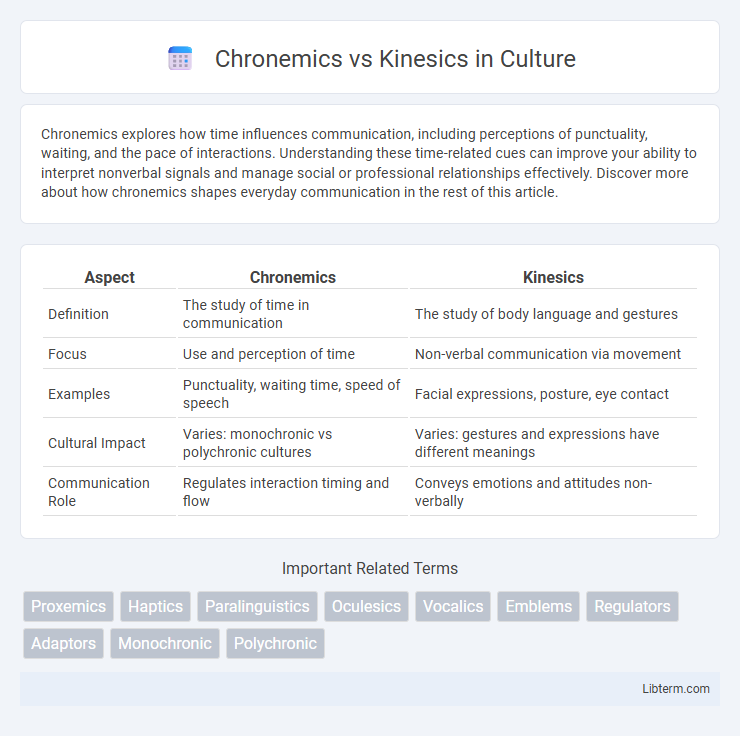Chronemics explores how time influences communication, including perceptions of punctuality, waiting, and the pace of interactions. Understanding these time-related cues can improve your ability to interpret nonverbal signals and manage social or professional relationships effectively. Discover more about how chronemics shapes everyday communication in the rest of this article.
Table of Comparison
| Aspect | Chronemics | Kinesics |
|---|---|---|
| Definition | The study of time in communication | The study of body language and gestures |
| Focus | Use and perception of time | Non-verbal communication via movement |
| Examples | Punctuality, waiting time, speed of speech | Facial expressions, posture, eye contact |
| Cultural Impact | Varies: monochronic vs polychronic cultures | Varies: gestures and expressions have different meanings |
| Communication Role | Regulates interaction timing and flow | Conveys emotions and attitudes non-verbally |
Introduction to Chronemics and Kinesics
Chronemics studies how humans perceive and use time in communication, analyzing behaviors like punctuality, pace, and waiting times to convey messages or emotions. Kinesics focuses on body language, including gestures, posture, facial expressions, and eye contact, as critical factors in nonverbal communication. Understanding chronemics and kinesics provides deep insights into interpersonal interactions, revealing how time-related and physical cues impact meaning and social dynamics.
Defining Chronemics: The Language of Time
Chronemics is the study of how time influences communication, focusing on the cultural and psychological perceptions of time in interactions. It examines how punctuality, duration, and the sequencing of events convey meaning and affect relational dynamics. Understanding chronemics reveals how time management and timing serve as nonverbal cues that regulate communication and express social hierarchy, power, and respect.
Understanding Kinesics: The Power of Body Language
Kinesics explores the intricate language of body movements, including facial expressions, gestures, posture, and eye contact, revealing unspoken emotions and intentions. Mastering kinesics enhances communication effectiveness by interpreting non-verbal cues that often speak louder than words. Recognizing subtle signals like microexpressions and body orientation provides deeper insight into interpersonal dynamics and cultural contexts.
Key Differences Between Chronemics and Kinesics
Chronemics studies the role of time in communication, analyzing how punctuality, waiting times, and time management convey messages, while kinesics examines body language, including gestures, facial expressions, and posture. Chronemics highlights temporal cues that influence interaction, such as monochronic and polychronic time orientations, whereas kinesics focuses on nonverbal signals that express emotions and intentions. Understanding these distinct components reveals how time-based behaviors and physical movements jointly shape human communication dynamics.
Cultural Influences on Chronemics and Kinesics
Cultural influences on chronemics reveal distinct perceptions of time, where monochronic cultures prioritize punctuality and schedules, while polychronic cultures emphasize flexibility and relationships. In kinesics, gestures, facial expressions, and body language vary significantly across cultures, impacting communication effectiveness and interpretation. Understanding these cultural differences is essential for cross-cultural communication, reducing misunderstandings, and fostering respectful interactions.
Chronemics in Everyday Communication
Chronemics, the study of how time influences communication, plays a crucial role in everyday interactions by shaping perceptions of punctuality, response times, and conversational flow. Time management cues such as pauses, speech rate, and turn-taking signal respect, urgency, or interest, directly impacting relationship dynamics and social hierarchies. Understanding chronemic patterns enhances effective communication across cultures, where varied time orientations affect expectations and interpretations in personal and professional settings.
Kinesics and Its Impact on Social Interactions
Kinesics, the study of body language, plays a crucial role in shaping social interactions by conveying emotions, intentions, and social cues beyond verbal communication. Gestures, facial expressions, posture, and eye contact contribute significantly to understanding context and building rapport in interpersonal exchanges. Misinterpretations of kinesic signals can lead to social misunderstandings, making awareness of cultural differences essential for effective communication.
Chronemics vs Kinesics: Practical Applications
Chronemics and kinesics offer distinct insights for effective communication in various settings. Chronemics, which studies the role of time in communication, helps professionals manage punctuality, response times, and scheduling to build trust and respect. Kinesics, the analysis of body language and gestures, enhances understanding of nonverbal cues, allowing leaders and educators to interpret emotions and intentions accurately, improving interpersonal interactions and conflict resolution.
Challenges in Interpreting Chronemics and Kinesics
Interpreting chronemics poses challenges due to cultural variations in the perception of time, such as monochronic versus polychronic time orientation, which can lead to misunderstandings in punctuality and scheduling. Kinesics interpretation is complicated by differences in nonverbal gestures, facial expressions, and body language that vary widely across cultures, potentially causing miscommunication. Both chronemics and kinesics require contextual awareness and cultural sensitivity to accurately decode the intended messages and avoid erroneous assumptions.
Conclusion: Integrating Time and Body Language in Communication
Integrating chronemics and kinesics enhances communication by aligning time management with body language cues, fostering clearer interpersonal interactions. Recognizing the cultural and contextual variations in timing and gestures improves message accuracy and relational dynamics. Effective communication requires synchronizing temporal patterns with nonverbal signals to convey intent and build trust.
Chronemics Infographic

 libterm.com
libterm.com